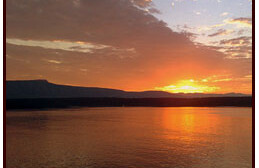Several qualifications regarding the various roles of religion should be mentioned at the outset. First, we do not wish to suggest here that any one religious tradition has a privileged ecological perspective. Rather, multiple perspectives may be the most helpful in identifying the contributions of the world's religions to the flourishing of life for future generations.
Second, while we assume that religions are necessary partners in the current ecological movement, they are not sufficient without the indispensable contributions of science, economics, education, and policy to the varied challenges of current environmental problems. Therefore, this is an interdisciplinary effort in which religions can play a part.
Third, we acknowledge that there is frequently a disjunction between principles and practices: ecologically sensitive ideas in religions are not always evident in environmental practices in particular civilizations. Many civilizations have overused their environments, with or without religious sanction.
Finally, we are keenly aware that religions have all too frequently contributed to tensions and conflict among ethnic groups, both historically and at present. Dogmatic rigidity, inflexible claims of truth, and misuse of institutional and communal power by religions have led to tragic consequences in various parts of the globe.
Nonetheless, while religions have often preserved traditional ways, they have also provoked social change. They can be limiting but also liberating in their outlooks. In the 20th century, for example, religious leaders and theologians helped to give birth to progressive movements such as civil rights for minorities, social justice for the poor, and liberation for women. More recently, religious groups were instrumental in launching a movement called Jubilee 2000 for debt reduction for poor nations.1 Although the world's religions have been slow to respond to our current environmental crises, their moral authority and their institutional power may help effect a change in attitudes, practices, and public policies.
The Challenge of the Environmental Crisis and the Role of Religions in Meeting ItThe environmental crisis has been well documented as a plural reality in its various interconnected aspects of resource depletion and species extinction, pollution growth and climate change, population explosion and overconsumption.2 Thus, while we are using the term "environmental crisis" in a singular form, we recognize the diverse nature of the interrelated problems. These problems have been subject to extensive analysis and scrutiny by the scientific and policy communities and, although comprehensive solutions remain elusive, there is an emerging consensus that the environmental crisis is both global in scope and local in impact. A major question we confront is: What are the appropriate boundaries for the protection and use of nature? The choices will not be easy as we begin to reassess our sense of rights and responsibilities to present and future generations, and to reevaluate appropriate needs and overextended greed regarding natural resources.Many organizations and individuals have been calling for greater participation by various religious communities in meeting the growing environmental crisis by reorienting humans to show more respect, restraint, and responsibility toward the Earth community.3 Consider, for example, a statement by scientists, "Preserving and Cherishing the Earth: An Appeal for Joint Commitment in Science and Religion," issued at a Global Forum meeting in Moscow in January of 1990. It suggests that the human community is committing "crimes against creation" and notes that "problems of such magnitude, and solutions demanding so broad a perspective, must be recognized from the outset as having a religious as well as a scientific dimension. Mindful of our common responsibility, we scientists—many of us long engaged in combating the environmental crisis—urgently appeal to the world religious community to commit, in word and deed, and as boldly as is required, to preserve the environment of the Earth." It goes on to declare that "the environmental crisis requires radical changes not only in public policy, but in individual behavior. The historical record makes clear that religious teaching, example, and leadership are powerfully able to influence personal conduct and commitment. As scientists, many of us have had profound experiences of awe and reverence before the universe. We understand that what is regarded as sacred is more likely to be treated with care and respect. Our planetary home should be so regarded. Efforts to safeguard and cherish the environment need to be infused with a vision of the sacred."4
Although the responses of religions to the global environmental crisis were slow at first, they have been steadily growing over the last 25 years.5 Just as religions played an important role in creating sociopolitical changes in the 20th century (e.g., human and civil rights), so now religions are poised in the 21st century to contribute to the emergence of a broader environmental ethics based on diverse sensibilities regarding the sacred dimensions of the natural world.
Religion and ecologyReligion is more than simply a belief in a transcendent deity or a means to an afterlife. It is, rather, an orientation to the cosmos and our role in it. We understand religion in its broadest sense as a means whereby humans, recognizing the limitations of phenomenal reality, undertake specific practices to effect self-transformation and community cohesion within a cosmological context. Religion thus refers to those cosmological stories, symbol systems, ritual practices, ethical norms, historical processes, and institutional structures that transmit a view of the human as embedded in a world of meaning and responsibility, transformation and celebration. Religion connects humans with a divine or numinous presence, with the human community, and with the broader Earth community. It links humans to the larger matrix of mystery in which life arises, unfolds, and flourishes.In this light nature is a revelatory context for orienting humans to abiding religious questions regarding the cosmological origins of the universe, the meaning of the emergence of life, and the responsible role of humans in relation to life processes. Religion thus situates humans in relation to both the natural and human worlds with regard to meaning and responsibility. At the same time, religion becomes a means of experiencing a sustaining creative force in the natural and human worlds and beyond. For some traditions this is a creator deity; for others it is a numinous presence in nature; for others it is the source of flourishing life.
This experience of a creative force gives rise to a human desire to enter into processes of transformation and celebration that link self, society, and cosmos. The individual is connected to the larger human community and to the macrocosm of the universe itself. The transformative impulse seeks relationality, intimacy, and communion with this numinous power. Individual and communal transformations are expressed through rituals and ceremonies of celebration. More specifically, these transformations have the capacity to embrace the celebration of natural seasonal cycles as well as various cultural rites of passage. Religion thus links humanity to the rhythms of nature through the use of symbols and rituals that help to establish moral relationships and patterns for social exchange.
The issues discussed here are complex and involve various peoples, cultures, worldviews, and academic disciplines. Therefore, it is important to be clear about our terms. As it is used here, the term "ecology" locates the human within the horizon of emergent, interdependent life rather than viewing humanity as the vanguard of evolution, the exclusive fabricator of technology, or a species apart from nature. "Scientific ecology" is a term used to indicate the empirical and experimental study of the relations between living and nonliving organisms within their ecosystems. While drawing on the scientific understanding of interrelationships in nature, we are introducing the term "religious ecology" to point toward a cultural awareness of kinship with and dependence on nature for the continuity of all life. Thus, religious ecology provides a basis for exploring diverse cultural responses to the varied earth processes of transformation. In addition, the study of religious ecology can give us insight into how particular environments have influenced the development of cultures. Therefore, one can distinguish religious ecology from scientific ecology just as one can distinguish religious cosmology from scientific cosmology.
This awareness of the interdependence of life in religious ecology finds expression in the religious traditions as a sacred reality that is often recognized as a creative manifestation, a pervasive sustaining presence, a vital power in the natural world, or an emptiness (sunyata) leading to the realization of interbeing.6 For many religions, the natural world is understood as a source of teaching, guidance, visionary inspiration, revelation, or power. At the same time, nature is also a source of food, clothing, and shelter. Thus, religions have developed intricate systems of exchange and thanksgiving around human dependence on animals and plants, on forests and fields, on rivers and oceans. These encompass symbolic and ritual exchanges that frequently embody agricultural processes, ecological knowledge of ecosystems, or hunting practices.7
Methodological Approaches to Study of Religion and EcologyThere is an inevitable disjunction between the examination of historical religious traditions in all of their diversity and complexity and the application of teachings or scriptures to contemporary situations. While religions have always been involved in meeting contemporary challenges over the centuries, it is clear that the global environmental crisis is larger and more complex than anything in recorded human history. Thus, a simple application of traditional ideas to contemporary problems is unlikely to be either possible or adequate. In order to address ecological problems properly, religious leaders and laypersons have to be in dialogue with environmentalists, scientists, economists, businesspeople, politicians, and educators. With these qualifications in mind we can then identify three methodological approaches that appear in the emerging study of religion and ecology: retrieval, reevaluation, and reconstruction. Interpretive retrieval involves the scholarly investigation of cosmological, scriptural, and legal sources in order to clarify traditional religious teachings regarding human-Earth relations. This requires that historical and textual studies uncover resources latent within the tradition. In addition, interpretive retrieval can identify ethical codes and ritual customs of the tradition in order to discover how these teachings were put into practice.In interpretive reevaluation, traditional teachings are evaluated with regard to their relevance to contemporary circumstances. Can the ideas, teachings, or ethics present in these traditions be adopted by contemporary scholars or practitioners who wish to help shape more ecologically sensitive attitudes and sustainable practices? Reevaluation also questions ideas that may lead to inappropriate environmental practices. For example, are certain religious tendencies reflective of otherworldly or world-denying orientations that are not helpful in relation to pressing ecological issues? It asks as well whether the material world of nature has been devalued by a particular religion and whether a model of ethics focusing solely on human interaction is adequate to address environmental problems.
Finally, interpretive reconstruction suggests ways that religious traditions might adapt their teachings to current circumstances in new and creative ways. This may result in a new synthesis or in a creative modification of traditional ideas and practices to suit modern modes of expression. This is the most challenging aspect of the emerging field of religion and ecology and requires sensitivity to who is speaking about a tradition in the process of reevaluation and reconstruction. Postcolonial critics have appropriately highlighted the complex issues surrounding the problem of who is representing or interpreting a tradition. Nonetheless, practitioners and leaders of particular traditions may find grounds for creative dialogue with scholars of religious traditions in these various phases of interpretation.
Diversity and Dialogue of Religions The diversity of the world's religions may seem self-evident to some, but it is worth stressing the differences within and between religious traditions. At the same time, it is possible to posit shared dimensions of religions in light of this diversity, without arguing that the world's religions have some single emergent goal. The world's religions are inherently distinctive in their expressions, and these differences are especially significant in regard to the study of religion and ecology. Several sets of religious diversity can be identified as being integrally related. First, there is historical and cultural diversity within and between religious traditions as expressed over time in varied social contexts. For example, we need to be sensitive to the variations in Judaism between Orthodox, Conservative, and Reform movements, in Christianity between Catholic, Orthodox, and Protestant varieties of the tradition, and in Islam between Sunni and Shiite positions.Second, there is dialogical and syncretic diversity within and between religions traditions, which adds another level of complexity. Dialogue and interaction between traditions engenders the fusion of religious traditions into one another, often resulting in new forms of religious expression that can be described as syncretic. Such syncretism occurred when Christian missionaries evangelized indigenous peoples in the Americas. In East Asia there is an ongoing dialogue between and among Confucianism, Daoism, and Buddhism that results in various kinds of syncretism.8
Third, there is ecological and cosmological diversity within and between religions. Ecological diversity is evident in the varied environmental contexts and bioregions where religions have developed over time. For example, Jerusalem is the center of a sacred bioregion where three religious traditions-Judaism, Christianity, and Islam-have both shaped and been shaped by the environment. These complex interactions illustrate that religions are not static in their impacts on ecology. Indeed, throughout history the relationships between religions and their natural settings have been fluid and manifold.
Religious traditions develop unique narratives, symbols, and rituals to express their relationships with the cosmos as well as with various local landscapes. For example, the body is a vital metaphor for understanding the Daoist relationship with the world: as an energetic network of breathings-in and breathings-out, the body, according to Daoism, expresses the basic pattern of the cosmos. Another example, from Buddhism, of a distinctive ecological understanding involves Doi Suthep, a sacred mountain in the Chiang Mai valley of northern Thailand: the ancient Thai reverence for the mountain is understood as analogous to respect for the Buddhist reliquary, or stupa.
Converging Perspectives: Common Values for the Earth Community The project of exploring world religions and ecology may lead toward convergence on several overarching principles. The common values that most of the world's religions hold in relation to the natural world might be summarized as reverence, respect, restraint, redistribution, responsibility, and renewal. While there are clearly variations of interpretation within and between religions regarding these six principles, it may be said that religions are moving toward an expanded understanding of their cosmological orientations and ethical obligations. Although these principles have been previously understood primarily with regard to relations toward other humans, the challenge now is to extend them to the natural world.As this shift occurs—and there are signs it is already happening—religions can advocate reverence for the earth and its profound cosmological processes, respect for the earth's myriad species, an extension of ethics to include all life forms, restraint in the use of natural resources combined with support for effective alternative technologies, equitable redistribution of wealth, the acknowledgement of human responsibility in regard to the continuity of life and the ecosystems that support life, renewal of the energies of hope for the transformative work to be done.
Just as religious values needed to be identified, so, too, the values embedded in science, education, economics, and public policy also need to be more carefully understood. Scientific analysis will be critical to understanding nature's economy; education will be indispensable to creating sustainable modes of life; economic incentives will be central to an equitable distribution of resources; public-policy recommendations will be invaluable in shaping national and international priorities.
But the ethical values that inform modern science and public policy must not be uncritically applied. Instead, by carefully evaluating the intellectual resources both of the world's religions and of modern science and public policy, our long-term ecological prospects may emerge. We need to examine the tensions between efficiency and equity, between profit and preservation, and between the private and public good. We need to make distinctions between human need and greed, between the use and abuse of nature, and between the intrinsic value and instrumental value of nature. We need to move from destructive to constructive modes of production, and from the accumulation of goods to an appreciation for the common good of the Earth community.
There has been much progress in the arena of religion and ecology. Indeed, a new academic field of study has emerged with implications for public policy. This is in large measure due to a three-year conference series at Harvard's Center for the Study of World Religions from 1996-1998, which resulted in ten edited volumes, a large website, the journal Worldviews: Global Religions, Culture, and Ecology, and the formation of the Forum on Religion and Ecology based at Yale University. Other milestones include the Encyclopedia of Religion, published in 2005. Thousands of people around the globe are now participating in this work, both in the classroom and in engaged projects for a sustainable future.
NOTES
1 The movement, which began in Britain, has had demonstrable influence on the decisions of the World Bank and other lending organizations to reduce or forgive debts in more than twenty countries. See http://www.jubilee2000uk.org/ 2 See, for example, IPCC Fourth Assessment Report, 2007 3 See http://www.thomasberry.org 4 "Preserving and Cherishing the Earth: An Appeal for Joint Commitment in Science and Religion," 1990. 5 For two examples of this, see: Stewardship or Sacrifice? Conference, October 2009, Rock Ethics Institute and Public Campaign on Climate Change, World Council of Churches 6 The term "interbeing" is used in the writings of the Vietnamese monk Thich Nhat Hanh. 7 See Eugene N. Anderson, Ecologies of the Heart: Emotion, Belief, and the Environment (New York and Oxford: Oxford University Press, 1996) and John A. Grim, ed., Indigenous Traditions and Ecology: The Interbeing of Cosmology and Community (Cambridge, Mass.: Center for the Study of World Religions, Harvard Divinity School, 2001). 8 See Judith A. Berling, The Syncretic Religion of Lin Chao-en (New York: Columbia University Press, 1980).





